The 1920 Ford Model T, more than just a car, was a symbol of American ingenuity and a catalyst for social change. Its impact transcended the automotive industry, shaping landscapes, lifestyles, and the very fabric of American society. This iconic vehicle, born from the innovative mind of Henry Ford, became a household name, its affordability and reliability democratizing transportation and ushering in a new era of mobility.
The Model T’s legacy extends far beyond its technological advancements. Its mass production revolutionized manufacturing, while its affordability empowered individuals to explore new horizons. The car’s impact on infrastructure, particularly the rise of paved roads and the burgeoning suburbs, was undeniable.
It became a cultural icon, appearing in literature, film, and popular songs, solidifying its place in American history.
The Birth of the Model T
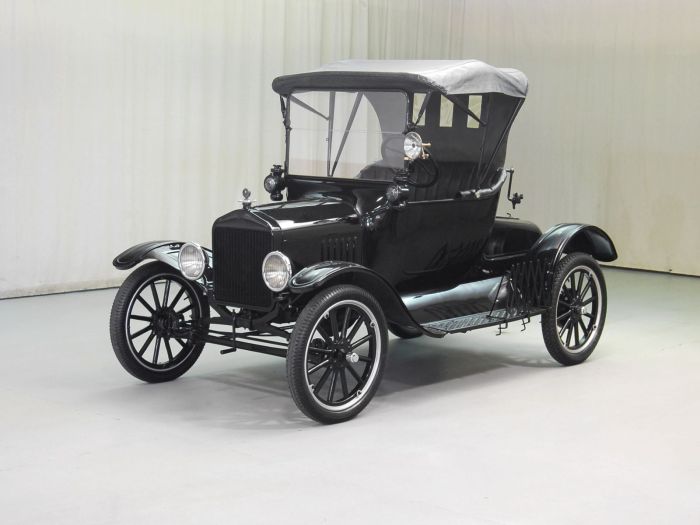
The Ford Model T, a car that revolutionized transportation and ushered in the era of mass production, was born in the early 20th century. It emerged during a time of rapid technological advancement and economic growth, shaping the automotive industry and leaving an enduring legacy on the world.
The Model T’s Revolutionary Innovations
The Model T was not just a car; it was a testament to Henry Ford’s vision of making automobiles accessible to the masses. The car’s success was driven by a combination of innovative engineering and manufacturing practices.
- Mass Production:Ford’s adoption of the moving assembly line revolutionized manufacturing. This system allowed for the efficient production of cars, reducing costs and increasing output significantly.
- Simplified Design:The Model T was designed with simplicity in mind. It featured a standardized design with interchangeable parts, reducing the need for skilled labor and making repairs easier.
- Affordable Price:By using mass production and simplifying the design, Ford was able to significantly reduce the cost of the Model T, making it affordable for a wider range of consumers.
- Reliable Engine:The Model T’s four-cylinder engine, with its simple design and robust construction, was known for its reliability and durability.
The Model T’s Design and Construction
The Model T was a simple yet revolutionary design. Its chassis was made of a sturdy steel frame, and the body was constructed of wood and metal. The engine, a four-cylinder gasoline engine, was mounted in the front and drove the rear wheels through a planetary transmission.
- Engine:The Model T’s engine, known as the “T-head” engine, was a four-cylinder, 2.9-liter engine that produced around 20 horsepower. It was designed for simplicity and reliability, featuring a single carburetor and a simple ignition system.
- Chassis:The chassis was made of a sturdy steel frame that provided a rigid foundation for the car. The suspension was simple, with leaf springs at the front and rear.
- Body:The Model T’s body was constructed of wood and metal. Early models had a simple, open-top design, while later models offered enclosed bodies and various configurations.
Production and Impact
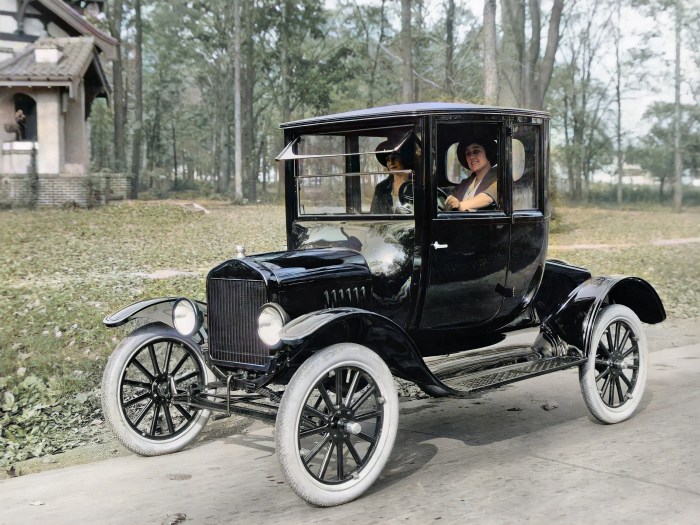
The Ford Model T, more than just a car, revolutionized transportation and shaped American society. Its affordability and mass production, pioneered by Henry Ford’s innovative assembly line system, had a profound impact on the world.
Impact of the Assembly Line
The assembly line, a revolutionary production method, transformed the Model T from a luxury item to a vehicle accessible to the masses. This system allowed for standardized, interchangeable parts, making production faster and more efficient. Each worker focused on a specific task, significantly reducing the time and cost of manufacturing.
The assembly line’s impact on the Model T’s affordability is undeniable.
“By 1914, the Model T had become so inexpensive that it could be bought for $550, about the price of a good horse and wagon.”
The American Pageant
This affordability enabled millions of Americans to purchase their own vehicles, transforming the transportation landscape.
Social and Economic Implications
The Model T’s widespread availability had significant social and economic implications. It fostered a sense of mobility and independence, allowing people to travel farther and faster than ever before. This newfound freedom contributed to the growth of suburbs, as people could commute to work in cities from more distant locations.
The Model T also spurred economic growth, creating jobs in related industries such as road construction, oil refining, and automobile parts manufacturing.
The 1920 Ford Model T, known as the “Tin Lizzie,” revolutionized transportation with its affordability and accessibility. It marked the beginning of the mass-produced automobile era. Fast forward to 1966, and Ford was still making waves with its iconic 1966 Ford Galaxie 500 , a symbol of American muscle car culture.
While the Model T paved the way for widespread automotive use, the Galaxie 500 exemplified the American dream of power and performance, showcasing how far Ford had come in just over four decades.
- The Model T’s impact on the American landscape was significant. It facilitated the growth of suburbs, allowing people to live outside of city centers and commute to work.
- The automobile industry, spurred by the Model T’s success, created millions of jobs and contributed to the nation’s economic prosperity.
- The widespread adoption of the Model T had a significant impact on American culture. It fostered a sense of freedom and mobility, leading to a more mobile and interconnected society.
Impact on Transportation and Infrastructure
The Model T’s impact on transportation was profound. It transformed the way people traveled, creating a need for improved roads and infrastructure. The development of a national road system, including the iconic Route 66, was largely driven by the rise of the automobile.
This network of paved roads connected cities and towns, facilitating trade, tourism, and personal travel.
- The Model T’s popularity led to a surge in demand for improved roads, prompting the development of a national road system.
- The construction of paved roads and highways facilitated the movement of goods and people, stimulating economic growth and contributing to the rise of the suburbs.
- The Model T’s influence on transportation infrastructure laid the foundation for the modern road network that we know today.
The Model T in Popular Culture
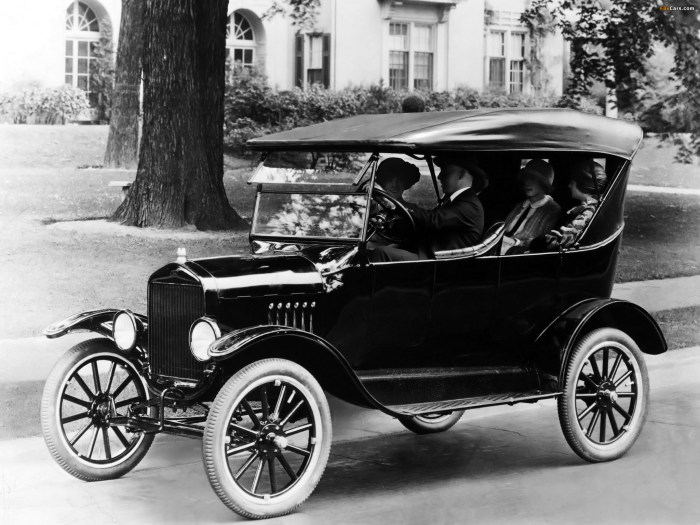
The Ford Model T, more than just a car, was a cultural phenomenon that permeated the fabric of American life in the early 20th century. Its impact extended beyond the realm of transportation, shaping literature, film, and popular culture in ways that continue to resonate today.
The 1920 Ford Model T, known as the “Tin Lizzie,” revolutionized transportation with its affordability and accessibility. While the Model T was a symbol of innovation, Ford’s engineering prowess continued to evolve, culminating in the robust 1951 Ford F4 , a workhorse truck designed for heavy-duty tasks.
The Model T, with its simple design and mass production, paved the way for the F-Series, showcasing Ford’s commitment to building vehicles that meet the needs of a changing world.
The Model T in Literature and Film
The Model T’s widespread adoption made it a ubiquitous presence in everyday life, making it a natural subject for writers and filmmakers of the era. Authors incorporated the Model T into their narratives, reflecting its role in shaping social dynamics and individual experiences.
- Literature: Sinclair Lewis, in his 1920 novel “Main Street,” used the Model T as a symbol of the changing American landscape, depicting its arrival in a small town and the disruption it brought to traditional values. The Model T also featured prominently in the works of other prominent American authors, such as Ernest Hemingway and F.
Scott Fitzgerald, who explored its influence on relationships and personal journeys.
- Film: The Model T’s presence in early films was equally significant. Silent films, like “The Perils of Pauline” (1914), showcased the Model T in thrilling chase scenes and dramatic escapes. The Model T’s association with adventure and freedom cemented its place in the popular imagination.
The 1920 Ford Model T, known for its affordability and revolutionary assembly line production, paved the way for the evolution of American automotive manufacturing. While the Model T was a symbol of mobility for the masses, the landscape of the automotive industry shifted considerably over the following decades.
By 1951, Ford had introduced the 1951 Ford F150 , a robust pickup truck that signaled a move towards more specialized vehicles, showcasing the company’s commitment to catering to diverse needs. This shift from the mass-produced Model T to the specialized F150 exemplifies the evolving demands of the American market and Ford’s ability to adapt to those changes.
The Iconic Status of the Model T
The Model T’s enduring legacy is a testament to its groundbreaking design and its role in revolutionizing personal transportation. The Model T’s iconic status is rooted in its simple, robust design, affordability, and its ability to connect people to the wider world.
- Design and Affordability: The Model T’s design, characterized by its distinctive black paint and its simplicity, became a symbol of American ingenuity and industrial prowess. The car’s affordability, achieved through mass production techniques, made it accessible to a wider audience than ever before.
- Impact on Automotive Design and Branding: The Model T’s influence on automotive design is undeniable. Its basic design elements, such as the use of a single, sturdy frame and the incorporation of interchangeable parts, became industry standards. Moreover, the Model T’s mass production model laid the foundation for the modern automobile industry.
The Model T’s Enduring Legacy
The Model T’s impact extends beyond its era, influencing automotive design and branding, and shaping the way we think about cars. The Model T’s legacy is celebrated in museums, historical societies, and automotive events worldwide.
- Museums and Historical Societies: The Henry Ford Museum in Dearborn, Michigan, houses a vast collection of Model T vehicles and artifacts, showcasing the car’s history and its impact on American society. The Model T is also featured in numerous other museums and historical societies around the world.
- Automotive Events: The Model T continues to be celebrated in automotive events, such as the annual Model T Ford Club of America’s national meet, which brings together enthusiasts and collectors from across the country. These events serve as a reminder of the car’s enduring appeal and its place in automotive history.
Technical Specifications
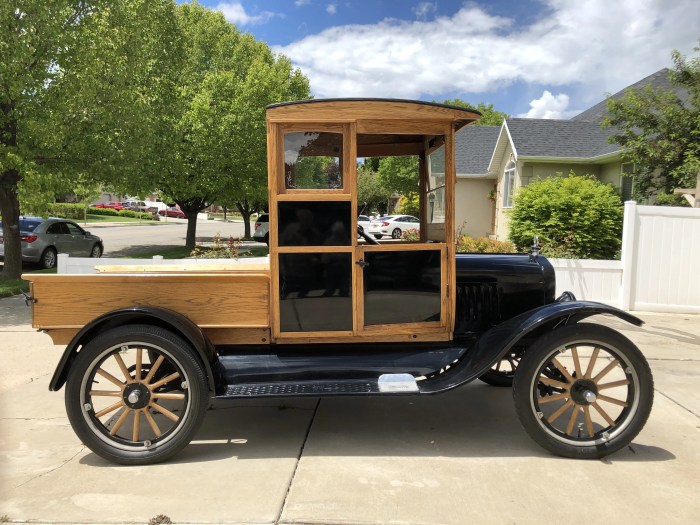
The Ford Model T, a revolutionary automobile that forever changed transportation, was not just a product of its time; it was a testament to innovative engineering and design. Its technical specifications, while simple compared to modern vehicles, were groundbreaking for their era.
Engine and Transmission
The Model T’s engine was a marvel of simplicity and reliability. It was a four-cylinder, 2.9-liter gasoline engine, producing a modest 20 horsepower. While not powerful by today’s standards, it was more than adequate for the roads of the time.
The engine was coupled to a two-speed planetary transmission, which was controlled by a lever on the steering column.
Steering and Brakes
The Model T’s steering system was a simple worm-and-sector design, requiring significant effort to turn the wheel, especially at low speeds. The brakes were also basic, relying on mechanical drum brakes on the rear wheels.
Suspension and Body Styles
The Model T featured a simple suspension system with leaf springs on all four wheels. The vehicle was available in a variety of body styles, including the popular touring car, which could seat five passengers, the sporty roadster, and the more enclosed coupe.
Lighting, 1920 Ford Model T
The Model T’s lighting system was rudimentary, consisting of acetylene lamps for headlights and tail lights.
Key Technical Specifications
The following table summarizes the Model T’s key technical specifications:
| Specification | Value |
|---|---|
| Engine | Four-cylinder, 2.9-liter gasoline engine |
| Horsepower | 20 hp |
| Transmission | Two-speed planetary |
| Suspension | Leaf springs on all four wheels |
| Brakes | Mechanical drum brakes on rear wheels |
Legacy and Enduring Influence: 1920 Ford Model T
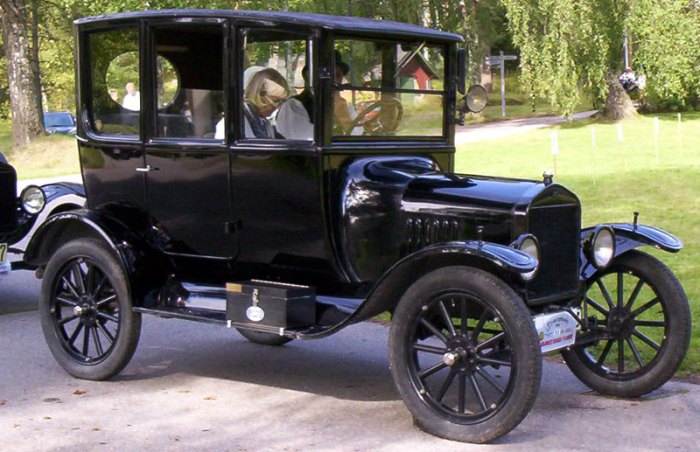
The Ford Model T, a revolutionary automobile that democratized transportation, continues to hold a significant place in history, leaving an enduring legacy that shaped the modern world. Its impact on the automobile industry, its role in shaping American culture, and its enduring symbolism as a testament to innovation and affordability remain relevant even today.
Comparison with Modern Automobiles
The Model T’s features and performance, though groundbreaking in their time, pale in comparison to modern automobiles. The Model T was powered by a simple, 4-cylinder engine, generating only 20 horsepower. This limited its top speed to around 45 mph and its acceleration was sluggish.
Its handling was also less precise, with a rigid suspension and limited braking capabilities. Modern cars, on the other hand, are equipped with powerful engines, advanced suspension systems, and sophisticated safety features that provide a vastly superior driving experience. The Model T’s limitations are a testament to the advancements in automotive technology over the past century.
While it revolutionized transportation, it also laid the foundation for the continuous evolution of the automobile.
Conclusive Thoughts
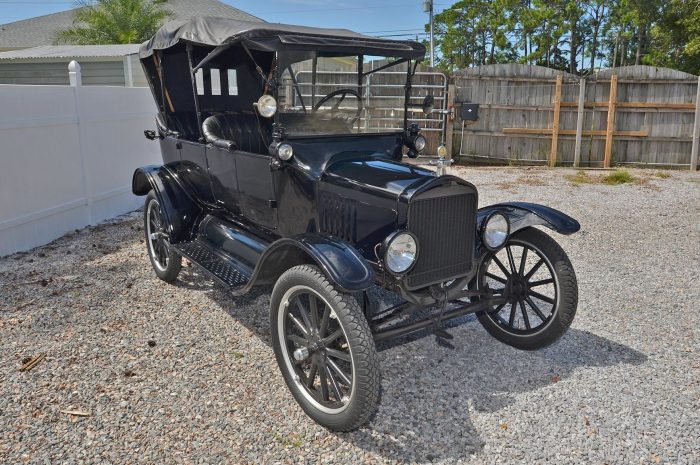
The 1920 Ford Model T stands as a testament to the power of innovation and its profound impact on society. Its legacy continues to inspire, reminding us of the transformative potential of technology and the enduring power of a well-crafted product.
From its humble beginnings as a revolutionary automobile to its iconic status in American culture, the Model T remains a symbol of progress, affordability, and the American spirit.